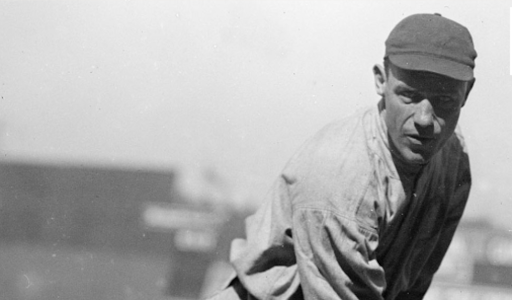Salida’s only contribution to Major League Baseball certainly wasn’t a superstar. But no one can make the argument that Tom Hughes didn’t have some super moments during his time in the show.
Nicknamed Salida Tom, Hughes was actually born in Coal Creek, Colorado. He pitched in the majors from 1906-18 for two teams that figure to be getting plenty of action at Colorado sports betting apps World Series future books this year. Hughes started out his MLB career with the New York Highlanders – today’s New York Yankees – in 1906. He would win a World Series with the Boston Braves – now the Atlanta Braves – in 1914.
Hughes came to reside in Salida as a young adult. His parents, His Richard and Kelzia Hughes, were Welsh immigrants. Richard Hughes worked as a locomotive engineer, which was likely what brought him to move his family to the railway town of Salida. Young Tom was working as a blacksmith in a railroad repair shop when he was offered a contract to play professional baseball. At 6-foot-2, 175 pounds, the lanky right-hander’s frame was considered large for that era of baseball.
Highlanders Bring Hughes To The Show
In 1905, the Highlanders opted to draft Hughes and then assigned him to the minor-league Atlanta Crackers, where he enjoyed a masterful season. Hughes went 25-5, allowing just 67 runs and 198 hits over 282 innings of work.
That performance earned Salida Tom a September call-up for his first taste of the show. He went 1-0 in three appearances. Hughes made his MLB debut in relief against the St. Louis Browns on September 18, 1906. On September 29, he’d earn his first big-league win, a 5-4 complete-game verdict over the Boston Americans.
He split the next two seasons between New York and the minor leagues. Hughes went 2-0 for the Highlanders in 1907. He was 16-9 with a 2.66 earned-run average for Newark of the Eastern League in 1908. That team was managed by George Stallings, someone who’d become very important in the advancement of Hughes over the years.
Earning a spot in the Highlanders starting rotation, the right-hander struggled with New York in 1909 (7-8) and 1910 (7-9), leading the Highlanders to sell his contract to Rochester of the Eastern League in 1911.
Hughes would win 64 games in four seasons with Rochester and led the league with 182 strikeouts in 1914. That same year, Stallings, who’d managed Hughes briefly in New York and against him with Buffalo while he was in Rochester, was named manager of the Braves. On September 5, 1914, the Braves, in the midst of a pennant drive, would purchase the contract of Hughes from Rochester.
Tied for first place with the New York Giants on the day Hughes was acquired, the Braves would go 27-7 the rest of the way to take the National League flag. Hughes won two games down the stretch, including a complete-game 3-2 victory over the Chicago Cubs on September 29 that officially clinched the pennant for Boston’s NL squad.
A World Series Champion
As the Braves were preparing to face the American League champion Philadelphia Athletics in the World Series, the accomplishments of Salida Tom were being celebrated back home.
“Mr. Hughes grew up in this city, spends his winters here and has a multitude of friends who take delight in his success and who would like to see him have a chance in the World Series,” reported the Mountain Mail. “His friends here have great confidence in him.”
While the Braves swept the A’s in the Fall Classic, unfortunately, Hughes was never called upon to take to the mound.
Strong Starter And Finisher
During the 1915 season, Hughes would display what a versatile hurler he was. He started 25 games, going 16-14 with a 2.12 ERA and 17 complete games.
As well, Hughes would work magic out of the bullpen for the Braves. He led the NL with 22 games finished and nine saves. His 50 appearances also topped the circuit. Hughes is among 17 pitchers in MLB history to start 20 games and record 20 games finished as a reliever in the same season.
Historic Achievement Taken Away
Salida Tom Hughes would pitch in the big leagues with the Braves through the 1918 season. In 1916, he went 16-3 for an NL-best .842 winning percentage. During his time in the show, he was originally credited with the unique feat of having thrown a no-hitter in both major major leagues.
Pitching for the Highlanders in an AL home game at Hilltop Park against the Cleveland Naps, Hughes no-hit Cleveland for nine innings, but the score remained 0-0. He gave up a single in the top of the 10th and then was lit up for six hits and five runs in the 11th, taking a 5-0 loss.
Things turned out much better for Hughes when he was facing the Pittsburgh Pirates on June 16, 1916. He would no-hit Pittsburgh 2-0. Hughes struck out Hall of Famer Honus Wagner for the final out of the game.
Initially, Hughes was given credit for two no-hitters. However, in September of 1991, the Committee for Statistical Accuracy, chaired by MLB Commissioner Faye Vincent, declared that the definition of a no-hitter to be any game of nine or more innings that concludes with one team getting no hits.
Confusion Over Hughes
Hughes finished his big-league career with a 56-39 record and a 2.56 ERA. His career WHIP with the Braves of 1.022 is the best in franchise history among pitchers with at least 300 innings of work.
Salida Tom Hughes died in 1961. Sadly, his work is often confused with that of Long Tom Hughes, another right-handed MLB pitcher of the same era. A link from Salida Tom’s Wikipedia page sends you to a bio of Long Tom Hughes. Some of the minor league pitching stats of both players are mixed up on Baseball Reference.
Keep an eye for more latest news & updates on Web of Buzz!




